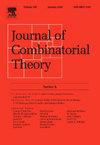On de Bruijn rings and families of almost perfect maps
IF 1.2
2区 数学
Q2 MATHEMATICS
引用次数: 0
Abstract
De Bruijn tori, or perfect maps, are two-dimensional periodic arrays of letters from a finite alphabet, where each possible pattern of shape appears exactly once in a single period. While the existence of certain de Bruijn tori, such as square tori with odd and even alphabet sizes, remains unresolved, sub-perfect maps are often sufficient in applications like positional coding. These maps capture a large number of patterns, with each appearing at most once. While previous methods for generating such sub-perfect maps cover only a fraction of the possible patterns, we present a construction method for generating almost perfect maps for arbitrary pattern shapes and arbitrary non-prime alphabet sizes, including the above mentioned square tori with odd as long that the alphabet size is non-prime. This is achieved through the introduction of de Bruijn rings, a minimal-height sub-perfect map and a formalization of the concept of families of almost perfect maps. The generated sub-perfect maps are easily decodable which makes them perfectly suitable for positional coding applications.
在德布鲁因环和几乎完美的地图上
De Bruijn tori,或完美映射,是有限字母表中字母的二维周期性数组,其中每种可能的形状模式(m,n)在单个周期内恰好出现一次。虽然某些de Bruijn环面(例如奇数m=n∈{3,5,7}和偶数字母大小的平方环面)的存在性仍未得到解决,但在位置编码等应用中,次完美映射通常是足够的。这些地图捕获了大量的模式,每种模式最多出现一次。虽然以前生成这种次完美映射的方法只覆盖了可能模式的一小部分,但我们提出了一种生成任意模式形状和任意非素数字母表大小的几乎完美映射的构造方法,包括上面提到的奇数m=n∈{3,5,7}的方形环面,只要字母表大小是非素数。这是通过引入de Bruijn环,一个最小高度的次完美地图和几乎完美地图族概念的形式化来实现的。生成的次完美地图很容易解码,这使得它们非常适合位置编码应用。
本文章由计算机程序翻译,如有差异,请以英文原文为准。
求助全文
约1分钟内获得全文
求助全文
来源期刊
CiteScore
2.90
自引率
9.10%
发文量
94
审稿时长
12 months
期刊介绍:
The Journal of Combinatorial Theory publishes original mathematical research concerned with theoretical and physical aspects of the study of finite and discrete structures in all branches of science. Series A is concerned primarily with structures, designs, and applications of combinatorics and is a valuable tool for mathematicians and computer scientists.

 求助内容:
求助内容: 应助结果提醒方式:
应助结果提醒方式:


